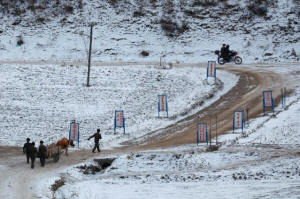|
A road trip along North Korea's border
with China
 Send a link to a friend
Send a link to a friend
 [April 13, 2018]
By Damir Sagolj [April 13, 2018]
By Damir Sagolj
(Reuters) - Through binoculars mounted atop
a tall building, I followed two women slowly making their way from the
other side, across the bridge. The rusted device was a military type,
and what I saw made them look as if they were targeted. It was very cold
and I struggled to place my lens on the binoculars to take a picture.
I was on the border between China and North Korea with my usual
reporting partner on such stories, Sue-Lin Wong, on a week-long road
trip. What we saw – from dirt-poor daily lives to clandestine economic
activity on the Korean side – included scenes not yet witnessed in
foreign media.
On the same rooftop as us, two tourists were holding hands as they
watched the women. They pulled out a selfie stick and took a picture
with the border in the background. Soon after, they gave up sightseeing.
But Sue-Lin and I stayed until my fingers were totally frozen from
taking pictures. Then we went down, too.
It was going to be dark soon, and the only light across the bridge was
from the portraits of North Korean leaders. On the Chinese side, under
the tower, very relaxed border guards were having fun filming themselves
with a video camera. We should have followed the women but I didn't know
what direction they went in. Instead, we went searching for the best
Korean barbecue in town.
I'm not a stranger to borders - I've spent good part of my life and most
of my career between countries, between war and peace, between "us and
them."

Whether it's the desert between Iran and Afghanistan, the gates of a
diplomatic compound in the former Soviet Union, or the frontline of a
besieged city in the bloody Balkan wars, they all have one thing in
common - they look very different depending on what side you are looking
from.
The borders of North Korea are an extreme example – nowhere in the world
is there such a difference between what life looks like on opposite
sides of the river or the fences that separate the two countries. I know
- I've seen the frontier from both sides.
For reporters, the border with China is the most interesting - the land
border with South Korea is so heavily fortified and impenetrable that
all you can do is cast a long glance over the Demilitarized Zone or hope
for a desperate soldier to make his escape. The sea border between the
two Koreas is lots of military vessels and the occasional artillery duel
between the two sides, which are technically still at war. The border
with Russia is the shortest, and remains bit of a mystery. It's high on
my wish list of places to visit.
But the 1,420 km (880 mile) long border with China is a real challenge.
Just like many reporters, I've visited places on it before, and got a
few pictures here and there. But this time we did what I had always
wanted - we drove from its south to its north end. In eight days we
drove through mile after mile of nothing, guarded by no-one.
Nothing guarded by nobody is actually a wonderful story, especially if
you are in the mood to really look.
There are familiar hotspots that offer an important, if simplified,
picture of relations between the two neighbors. Closely scrutinized or
heavily fortified sections at each end - around the towns of Dandong and
Tumen - are what we usually see in media reports, their monotony made a
little more cheerful by Chinese tourists.

In between is mostly darkness on the North Korean side and long, cold
sections of emptiness on the Chinese side. Counted in hours of driving
without seeing a soul, it is only interrupted by a shiny little border
town or an occasional, mostly stalled project between two countries. A
half-finished river dam, an economic zone that employs only ghosts, a
bridge to nowhere...
We drove very close to the fence. As we went deeper, it transformed from
monstrous multilayered razor wire garnished with all sorts of cameras
and hi-tech sensors to a primitive barrier of loose and rusted wire,
similar to what I've seen separating godforsaken municipalities in,
let's say, rural Bosnia.
At one point, we randomly drove off the main road to find the border
fence had become totally useless - its barbed wire folded and pinned
back by a fraying piece of clothing so that an adult could easily pass.
Behind it, on the banks of the river, three small boats seemed ready to
ferry you over in no time. Unless you wanted to walk: The water is
frozen solid at this time of the year.

[to top of second column]
|

North Koreans are photographed from the Chinese side of the border
south of Changbai in China as they make their way through a small
village south of Hyesan in North Korea, November 22, 2017.
REUTERS/Damir Sagolj

On the other side was total, deep and enduring darkness, its silence
challenged only by an occasional bicyclist chased by a dog on a dirt
road, or a soldier carrying buckets of water from a frozen river. These
souls – like the people I used to see on trips outside the capital
Pyongyang - are often alone, gazing ahead of their feet, struggling
under the weight.
Driving along those frozen fields, past villages with rickety houses
or small, dirty industrial towns, I only rarely saw people actually
interacting with each other - once two women fighting, the other
time, three beautiful little girls in new red boots playing while
they fetched the water.
Then, this being North Korea, came totally unexpected and confusing
scenes. Just outside Linjiang, as the road started winding towards
the mountains, we spotted people waist-deep in the river - a group
of maybe 20 men wearing weird rubber orange suits, as if they were
in a very old and very cheap sci-fi movie. We stopped immediately
and I got my longest lens from the back of the car.
Locals said they were North Koreans – I saw military guards on the
other side who closely monitored their work. As I was frantically
taking pictures, Sue-Lin asked the Chinese what was going on. The
locals said they were looking for gold.
It was practically impossible to check on the spot, so we decided to
just photograph these people hunting in a half-frozen river, in
sub-zero temperatures, and find out more later. Then, experts and
documents confirmed that people do indeed search for gold in the
Yalu river, so the gold story could be true. We asked North Korean
officials about claims "Office 39," which procures luxury goods for
North Korea's ruling Kim family, has a hand in the gold mining, but
they didn't respond.

There may be gold in North Korea's streams but on the Chinese side,
there are some extremely bright lights. Linjiang and some other
towns seem to compete for who has the most brilliant or outlandish
decoration. It's as if they want to make a point, to show people on
the other side what China has achieved as it emerged from its dark
ages.
At a river island in Linjiang, across the frozen nothing, an
enormous video screen turned towards North Korea. While we were
there, it showed Chinese army propaganda videos and broadcast
warning messages forbidding any activity that might lead to
instability along the border.
That reminded me of an important point: While we got a sense that
the border is porous, it would be wrong to suggest China was in any
way less than vigilant. Besides what we couldn't see with naked eye
- thermal sensors, satellites and who knows what else - occasional
cameras are mounted above and alongside the road, and strategically
placed checkpoints are manned by heavily armed military.
I guess we were an odd couple - a Chinese Australian woman and a
Bosnian man – and it was not surprising that the Chinese police
stopped us at every one. Once identified, we were sent out of the
area immediately with no further discussion. Simple as that. No
hanging about to take pictures.
So one part of the border - an impoverished and undeveloped section
in the middle - remains a dark spot on our map. People say the
Chinese are building up their military installations to prevent a
possible influx of North Korean refugees if "something serious
happens."
What they are doing, the soldiers told us, is secret.
(Edited by Sara Ledwith)
[© 2018 Thomson Reuters. All rights
reserved.]
Copyright 2018 Reuters. All rights reserved. This material may not be published,
broadcast, rewritten or redistributed.
Thompson Reuters is solely responsible for this content.
 |